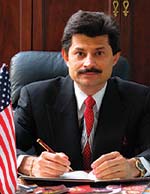William Faloon
William Faloon compiled the 1,500 page medical reference book
Disease Prevention and Treatment and his latest book is
Pharmocracy: How Corrupt Deals and Misguided Medical Regulations Are
Bankrupting America—and What to Do About It.
He is also Director and Cofounder of the
Life Extension
Foundation.
The Life Extension Foundation is a nonprofit organization, whose
long-range goal is the radical extension of the healthy human lifespan.
In seeking to control aging, their objective is to develop methods to
enable
us to live in health, youth, and vigor for unlimited periods of time.
The
Life Extension Foundation was officially incorporated in 1980, but the
founders have been involved in antiaging research since the 1960s.
When he and Saul Kent established the Life Extension Foundation in
1980, they had no idea what they were in for. As young men, their
objective was to
raise public awareness about the fact that pathological aging need not
be an inevitable consequence of human maturation. They were convinced
that
if the public could be enlightened about the importance of anti-aging
research, greater resources would be devoted to finding ways to
significantly extend the healthy human lifespan.
Back in 1980, few scientists believed that anything could be done to
prevent the degenerative effects inflicted by aging. To counter this
misconception, Bill pointed to then-current scientific studies
showing that it was possible to prevent some age-related diseases and to
slow the aging process itself, at least in animals. He argued that if
enough funds were committed to research, therapies to retard human aging
could be developed that would result in the greatest revolution in
medical history.
Few people in 1980 thought that intervention into biological aging was
possible, and many questioned why Bill would want to interfere with
nature. He argued that aging was the greatest scourge afflicting
humanity and that if people had the opportunity to live longer, many of
society’s problems would disappear.
Bill based his philosophical arguments on theories that people with
limited lifespans are not particularly motivated to protect society’s
long-term interests, since they themselves have only a relatively short
time to live. Longer lifespans, he asserted, would result in people
behaving in a manner that would make the world a better place, since
they themselves would have to exist in the environment they create.
Being controversial carries a heavy price. The news media viciously
attacked his position and had no problem finding academic scientists to
denigrate him in every way possible. The federal government raided his
facilities twice, initiated an 11-year criminal investigation, and threw
him and Saul Kent in jail in 1991.
Bill retaliated by filing multiple lawsuits against the federal
government, which resulted in the return of all the property it had
seized from him. He rallied health freedom activists to
keep the FDA from
turning vitamins into drugs. He enlightened Americans about the
availability of lower-cost prescription drugs in other countries. And he
eventually convinced the US Attorneys’ Office to dismiss the criminal
indictments brought against him by the FDA.
One benefit of all this controversy was that even though the news media
did not treat him well, it did report what he was doing. Because of
this
media coverage, many enlightened people found out about the Life
Extension Foundation, joined as
members, and even made substantial donations to support
it.
When the FDA conducted its first armed raid in 1987, the Life Extension
Foundation had only 4,000
members. Thanks to publicity generated by the FDA’s actions, this number
grew to 25,000 members by the time his criminal indictments were
dismissed in 1995. LEF now has over 100,000 members and each month mails
300,000 copies of
Life Extension Magazine to newsstands, subscribers,
and members.
To promote Life Extension’s innovative medical concepts, Bill
has been featured in hundreds of media appearances including The Phil
Donahue Show, The Joan Rivers Show, Tony Brown’s Journal, ABC News Day
One, and Newsweek magazine.





